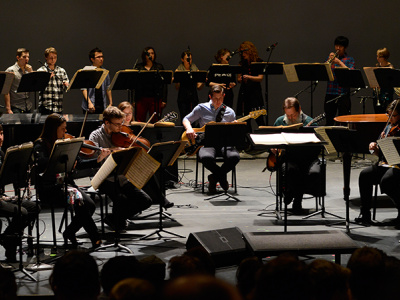What does an Orchestra Musician do?
For many classically trained musicians, landing a permanent position in an orchestra is the dream. Perhaps this is because orchestra positions provide job security, a good salary, medical benefits, and the opportunity to play regularly with other outstanding musicians. Or perhaps it's because, in many ways, the orchestra is one of the last pure temples of musical worship in existence. In a world where being employed full-time solely to play and perform music is an absolute rarity, the orchestra harkens back to an older time, when patrons of the arts would support musicians out of nothing more than a deep appreciation for their craft. As such, an orchestra member's job requires only learning, rehearsing, and performing the orchestra's repertoire with skill and passion.
There are opportunities for orchestral musicians all over the world, with a particularly large concentration in Europe.
There are four large groups of instruments in an orchestra: strings, woodwinds, brass, and percussion. Each of these groups is broken into a number of subgroups, also called sections, based on instrument; for example, the orchestra's many strings players are grouped into two violin sections, a viola section, a cello section, and a double bass section. Each section is in turn led by a principal player, also called a section leader or first chair, who is tasked with playing orchestral solos, signaling entrances and exits, and determining technical details like bowing or breathing. Orchestra members are charged with listening closely and working together to find cohesion and balance within the larger group—a task in which they are led by their conductor and music director, the orchestra's concertmaster, and the section leaders.
At a Glance
Most orchestra musicians start their professional careers soon after earning a bachelor's or master's degree, usually from a conservatory music performance program. Many begin by working in community and regional orchestras, honing their craft before auditioning for more prestigious orchestras in larger cities, where paychecks—and the average level of playing—are higher. Auditions are a major part of every orchestra musician's early career.
Once employed by an orchestra, musicians can advance within their instrumental section, climbing to become the principal player, also known as the section leader; the section leader of the first violins is a special position called the concertmaster. Section leaders often stay in their positions for decades, meaning opportunities to take these seats tend to be rare. In addition to playing for better and better orchestras, skilled orchestra musicians can go on to become conductors or music directors, pursue a career as a soloist, start their own music ensembles as bandleaders, or become involved with education or public outreach as nonprofit artists, music teachers, or professors.
For an orchestra musician just starting out, auditions are the only real way to secure a position with an orchestra. That's why the best method for finding work is to audition wherever possible, without worrying too much about which orchestras might be above or below one's level. Although auditions are universal, every orchestra has its own process for finding new members, and it greatly behooves an aspiring orchestra musician to learn these conventions.
Making the most of the audition process means keeping an eye on union resources like the American Federation of Musicians website, taking advantage of networking opportunities, picking the brains of former teachers who may have connections with specific orchestras, and independently keeping track of which orchestras are holding open auditions and when. It's important for musicians in the thick of this process to avoid getting discouraged or unconsciously limiting themselves to a small group of orchestras. There are opportunities for orchestral musicians all over the world.
- High-level instrumental performance
- Orchestral repertoire
- Excellent sense of tempo, dynamics, and phrasing
- Music theory
- Reading music notation
- Collaboration
Becoming and remaining an elite musician requires a high level of discipline and dedication. In addition to an exceptional work ethic, aspiring orchestra members need patience, tenacity, confidence, and the ability to perform at a high level under immense pressure. On a personal level, being collaborative, accommodating, and friendly can help orchestra members thrive in the tight-knit work environment that is an orchestra. Needless to say, the most important quality for an orchestra musician is to be a team player—both figuratively and literally.
Orchestra members spend an average of 20 hours per week performing and rehearsing, time that is broken into approximately eight "services", a catchall term that encompasses both rehearsals and concerts. They tend to work in the morning or at night, including on weekends and often major holidays. The average orchestra season is 40 weeks long, leaving plenty of time—usually in the summer—for orchestra musicians to go on vacation, spend time with their families, and develop their craft. Most members of prominent orchestras go on tour at some point in their career, which means some time away from home.






